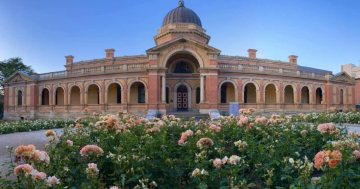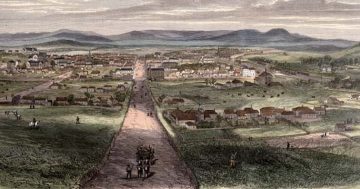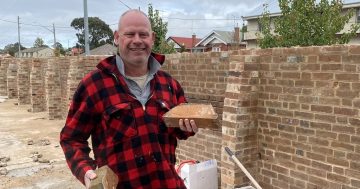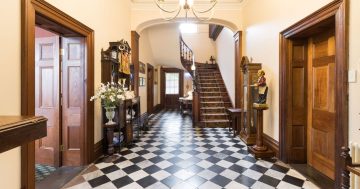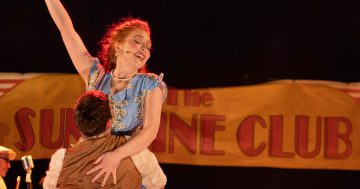
Steve Ayling with a print showing one of his ‘architectural landscapes’, a layering of buildings from a style he first noticed in London years ago. Photo: John Thistleton.
It took time, study, practice – lots of practice – and the affirmation of his community, but these days Steve Ayling describes himself as an artist.
After a notable 30-year career in Defence in Canberra and overseas and years of consulting, Steve Ayling returned to a lifelong interest in architecture, which he expresses today through fine sketching.
Since leaving Wamboin 10 years ago Steve and his wife Claire have run a guest house in historic Goulburn, an ideal setting for developing his interest in historic buildings and drawing.
Enrolling in courses, reading widely and many years of travel have helped his flair with fine-line pen, paper and ink. Eventually he turned his interest into a little venture. Today Steve sells his prints at Goulburn community market stalls and is occasionally commissioned to draw homes and significant Goulburn buildings like the Court House and redeveloped Old Town Hall and Old Cathedral.
Success did not come overnight. He had to first overcome his own misgivings about his talent, evident since his boyhood but set aside for years. After he retired from Defence his wife Claire suggested he enrol in a watercolour course in Canberra.
“Anyone can draw or paint but it’s best to get some lessons to get you on your way,” he said.
“The first teacher would talk in terms of ‘paint miles’. She would say, ‘Oh for God’s sake, just do it, build your passion, start small’.
“I found I could do it and enjoyed it, but it was landscapes and flowers, life drawing and that sort of stuff.”
Travelling abroad with Claire and continuing to practise drawing, he grew curious about the buildings including cathedrals and streetscape schemes and decided to learn more about architecture.
Far from satisfying his curiosity, online Oxford University courses looking at Western and modern architecture fuelled his interest in more studies. He has been studying and reading ever since, learning all he could about art and architecture from ancient to contemporary periods.
Finding joy in drawing buildings, he unearthed a compulsion to know the “why” behind a building’s design, changes over time, the different techniques and materials used to create it and the architectural choices.
He says most people would have found his reading choices dreadfully dull. He, on the other hand, absorbed the information like a sponge. From Renaissance to Baroque and Neoclassical, he gained an understanding of what motivated the architects and how architecture had evolved since before 1000 BC. It opened up the related field of town planning throughout the ages.
“The reason London became a modern city with thoroughfares and so forth was the Great Fire of London,” he shares.
“It swept through, destroyed the old part of the city and (Christopher) Wren and others wanted to put it on a better, modern system, introducing setback regulations, sanitation and rules for materials.
“I find it very interesting.”

The artist with other examples of his work. Photo: John Thistleton.
Thanks to extensive study he can see the overriding sense of purpose in Goulburn’s early town plan in the older, central areas, including where he and Claire run the historic Mandelson’s of Goulburn guest house.
“In the original (Goulburn) grid there is a town square, court house overlooking the town square, a place for the cathedral up the rise where the Anglican cathedral is, which was prime real estate – the Catholics got pretty ordinary real estate,” he said.
“The city was designed with wide roads, laneways, ease of getting around, impressive quality of life.”
His sketching reached a turning point when people started inquiring about his work and finally, having sold enough of his work, he found the confidence to call himself an artist.
He has sketched all the significant buildings in Goulburn, then hit on the idea of “architectural landscapes” – stacking structures together. He recalls buying a print about three decades back of iconic buildings in London, with a similar stacking style.
His friends were fascinated. The then-Mayor Bob Kirk asked for copies for his meeting room for a talking point when visitors to Goulburn called.

An architectural landscape of significant Goulburn buildings. Photo: John Thistleton.
“The attraction for me is in addition to capturing the architecture, it reflects the confidence of the founding fathers over the time to build extraordinary buildings. Cities and towns develop a society, culture, reputation, folklore and traditions. That’s the really interesting bit,” Steve said.
“The point of commissions: I make a bit of money, that doesn’t matter, but people are immensely proud of their home for various reasons.
“Either it’s grand, or they found it, bought it, renovated it and that’s what people love.”
Behind each of Steve’s sketches there is a wealth of knowledge about the building’s origins, which adds a layer of satisfaction for the artist and people displaying his work.






